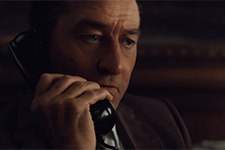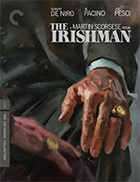The Irishman [Blu-Ray]
|

With The Irishman, Martin Scorsese returns to the organized crime drama, the terrain that first garnered him significant notice as a filmmaker (with 1973's Mean Streets), earned him some of the strongest accolades of his career (numerous lists have named 1990's GoodFellas as the best film of that decade), and finally won him multiple Oscars (for 2006's borderline self-parodic The Departed). And, despite the fact that it was The Departed that finally earned him his golden statue from the Academy, it is really GoodFellas that haunts Scorsese's career. As I noted when writing about The Departed in 2006, GoodFellas is the perennial Scorsese classic, especially among excitable young cineastes who feed off its energy and intensity, its violence and its black comedy, its irresistible narrative momentum. Like Taxi Driver (1976) in the '70s and Raging Bull (1980) in the '80s, GoodFellas is the film that Scorsese has been forced to live up to ever since, and many dismissed 1995's Casino right out of the gate for the simple reason that it was too much like it and fell too far short. There might be a tendency to react similarly to The Irishman, which on the surface has a great deal in common with both GoodFellas and Casino, including the casting of Robert De Niro and Joe Pesci, the Italian Mafia setting, and its epic run time (The Irishman clocks in at over three and a half hours, while the other two films ran two and a half hours and just under three hours, respectively). And, for some, the length of The Irishman is a problem, but I see it as one the film's real strengths and a key component of what differentiates it from Scorsese's previous mob films. The real distinction here is the tone that Scorsese strikes. While both GoodFellas and Casino were at times manic in their energy, their narrative, and their aesthetics, The Irishman is very nearly funereal in its tone and look. It is a slow burn, a gradual descent, and thus its longer runtime make sense as a temporal corollary to its more restrained aesthetic approach. Scorsese and cinematographer Rodrigo Prieto, who has worked multiple times with Alejandro González Iñárritu, Ang Lee, and Oliver Stone and who previously shot Scorsese's The Wolf of Wall Street (2014) and The Silence (2016), establish the film's tone in the opening moments, as we enter the film on a long, languid tracking shot through … wait for it … a retirement home, finally landing on the film's protagonist and the "Irishman" of the title, Frank Sheeran (Robert De Niro) as an aged old codger in a wheelchair. It is from this perspective that the film is told, and unlike the frantic, exhilarated narrative of Ray Liotta's Henry Hill, Frank is in no hurry. The tale he has to tell is one of violence and fury and betrayal and anger, but he tells it from a distanced position of age and isolation that renders his words imminently practical. There is a key scene near the end of the film where Frank, trying to make amends for his violent life, meets with a priest (Jonathan Morris) to pray for forgiveness, but is unable to feel anything. He doesn't feel guilt or regret or sadness for what he has done, even though intellectually he knows that he should and, on some level, wants to. Frank has led a violent life for so long that the violence has become just another facet of existence, no more or less meaningful than anything else (the film covers about 40 years, and the actors have been made to look younger and older with a mix of groundbreaking digital effects and make-up that is, for the most part, quite seamless). At one point he describes the assassination of a man who, it was later discovered, didn't do what he was killed for, as a "bad hit," and he says it with a kind of aural shrug that most of us would associate with accidentally bumping into someone in a crowd. And yet, despite his apparent lack of emotion and seemingly infinite capacity for violence, Frank remains a deeply sympathetic character for whom we feel and eventually mourn. De Niro's performance is one of constant control, as Frank is not, for the most part, a man given to grand physical displays or dramatic proclamations or even raising his voice; that is reserved for his boss, the infamous Teamster head Jimmy Hoffa (Al Pacino). Frank is most often a portrait of calm collectedness, which is part of what makes him so dangerous as an assassin; no ever sees it coming from him. Yet, De Niro's face and his eyes often betray what Frank is thinking and feeling when no one else is looking. This is where we get to see what others don't. We don't get a lot from Frank, but what he does give us when he is in moments of privacy can be deeply affecting if only because it is simultaneously so rare and so insightful. The scene in which Frank has been ordered to be on a plane to kill someone to whom he has been loyal for years is a small masterpiece of acting and directing, as Scorsese resists any urge to pump the scene for pathos and drama, but instead holds the camera on Frank in a medium shot as he sits there, his internal world in absolute conflict as he wordlessly wrestles with the reality that he is about to become a Judas figure. Caught between multiple allegiances, he must ultimately answer to the highest power, which in this case is mob boss Russell Bufalino (Joe Pesci), for whom Frank has worked for decades. Pesci, who won an Oscar for his live-wire portrayal of a particularly sadistic and unpredictable gangster in GoodFellas, does something completely different here, playing a man for whom power is such a natural extension of his being that virtually nothing fazes him. He remains steadfastly in control because he is secure in his place, which is quite the opposite of Pacino's Hoffa, who is constantly storming, ranting, and intimidating because he knows on some level just how precarious his place at the top of the union is. Pacino has been derided in the past for his overacting, and while he falls back on some of those tendencies here, Scorsese shapes and molds them in concert with the material. Pacino's grandiosity becomes Hoffa's mask for his insecurity, which makes him, like Frank, a deeply sympathetic character despite his outwardly noxious behaviors. The film is primarily about the relationship between Frank and Jimmy Hoffa, which is perhaps why Scorsese allows the title of the book on which it is based, I Heard You Paint Houses, to appear at the beginning of the film (the title The Irishman appears at the end, suggesting that the film officially has two titles). The original title refers to the first thing Hoffa says to Frank, a kind of code for his particular line of work. But, what makes the title matter is the personal pronouns that link the two men, suggesting that their interpersonal connection—which is one of both mutual respect and a growing sense of comradery if not brotherhood—provides the film its emotional backbone. Whatever you want to call it, The Irishman is a film about violent men who use violence and react to it in distinctly different ways, which gives it an emotional texture and thematic depth and nuance that too many crime movies lack. Scorsese dials down his own stylistic tendencies toward the flashy and the elaborate (directorial choices that sunk 2002's Gangs of New York, for example) and instead relies on the steady march of the narrative and the evolution of the on-screen relationships. The masterfully balanced screenplay by Steven Zaillian gives Scorsese a great deal to work with and a cast of colorful characters who at times provide some delicious black humor (the back and forth between Frank and Louis Cancelmi's Sally Bugs about who is going to sit in the front seat of a car—i.e., the place where one could easily be capped—is both humorous and suspenseful). There are lots of characters with names like "Fat Tony" and "Fitz" and "Whispers" and "Tony Pro," and Scorsese and his longtime editor Thelma Schoonmaker pace the film in such a way that we don't lose track of them and their often complicated interrelationships. Like many a mob movie, a lot of the drama comes down to who steps on whose toes and refuses to apologize, but Scorsese makes palpable the constant presence of violence amid the carefully laid rules of engagement. Frank's crucial betrayal forces him to work both inside and outside of those rules, and the scene in which he must call the wife of the man he has killed and pretend like he doesn't know anything is very nearly heartbreaking, which is saying something when we know he's a cold-blooded killer. Perhaps it is because we have seen how he was initially shaped into a killer by his military experience in World War II—orders are orders, after all—or perhaps it is because De Niro constantly allows us to see the pained humanity lurking just beneath his placid exterior, but The Irishman transcends mob movie clichés and stereotypes by digging into the humanity of those who often do everything in their power to be inhumane.
Copyright © 2020 James Kendrick Thoughts? E-mail James Kendrick All images copyright © Netflix / The Criterion Collection | |||||||||||||||||||||||||||||
Overall Rating:



 (3.5)
(3.5)
Subscribe and Follow
Get a daily dose of Africa Leader news through our daily email, its complimentary and keeps you fully up to date with world and business news as well.
News RELEASES
Publish news of your business, community or sports group, personnel appointments, major event and more by submitting a news release to Africa Leader.
More Information
